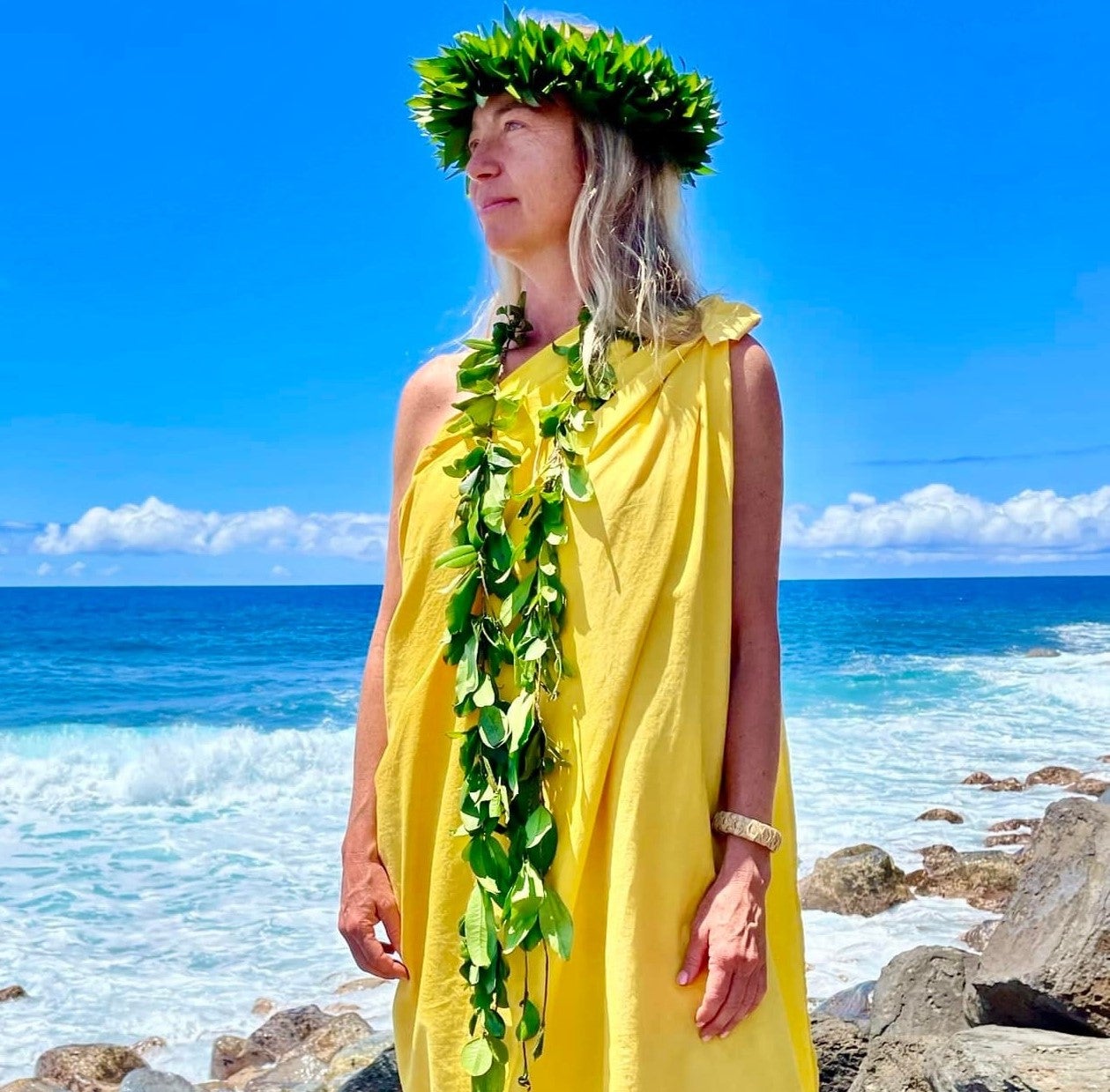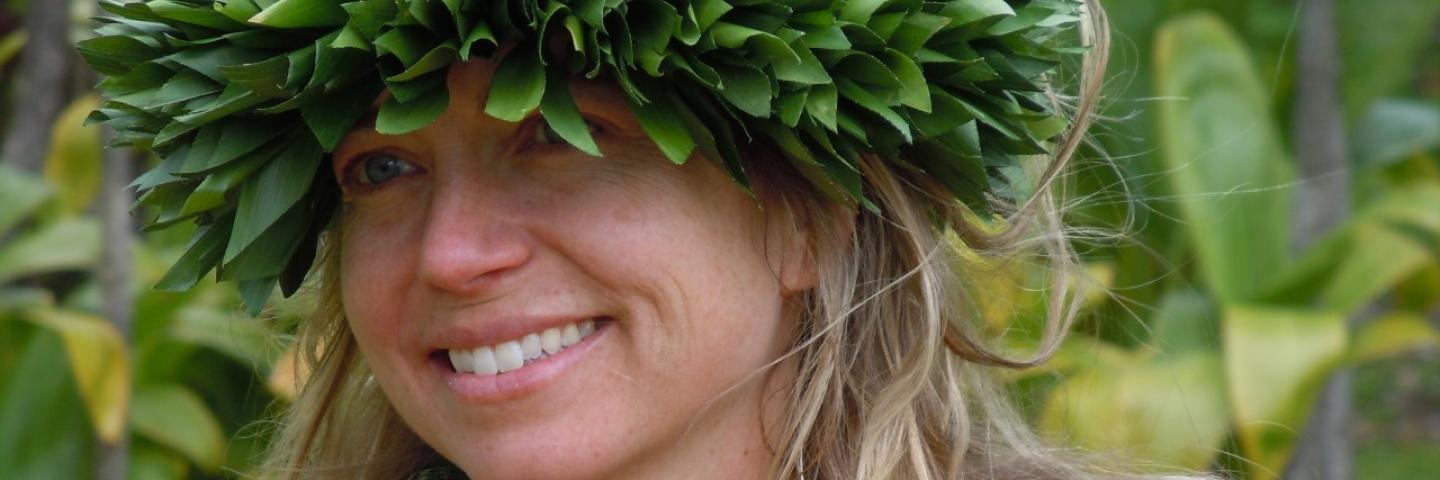ARTIST BIOGRAPHY
 | Traditional Skill/Art: Hawaiian Hula Dancing Years Won: 2022 Contact Information: Phone: (541)324-6111 Email: hulaanuenue@gmail.com Website: https://www.ashlandhula.com/ and |
Andrea is the Kumu Hula [master teacher] for Hālau Hula Ka Pi’o O Ke Ānuenue “the arch of the rainbow”, a Hawaiian cultural dance school she formed in 2007. She has taught hula in her community since 2003, and in 2014 became an ‘uniki [graduated] kumu hula, under Kumu Hula Raylene Haʻaleleʻa Kawaiaeʻa and Kumu Hula Keala Ching, both native Hawaiians, and the hula traditions of Halau ʻO Haʻaleleʻa and Na Wai ʻIwi Ola, respectively. This formal and rigorous training in the protocols and practices of hula granted her the kuleana "responsibility" to steward and perpetuate these lineally-connected traditions. Andrea was also hanai-ed [adopted] into the lineage of Kumu Hula Sybil Ku’uipo Pruett, who remains a significant mentor of kupuna [elder] wisdom to her today.
The primary focus in Kumu Andrea’s hālau is hula kahiko [ancient style], hula ʻauana [modern style], oli [chant], and nā mea hula [arts, crafts, implements]. As a kumu hula, Andrea shares the spirit and tradition of hula through classes, workshops, retreats, and other educational programs for all ages and levels, as well as through performance events, both regionally and in Hawai’i. Her intention is to inspire, empower, and elevate through perpetuating the sacredness of Hawaiian hula and chant.
Kumu Andrea also has a Masters of Arts degree in Dance and Spirituality, and is the founder and president of Kapiʻoānuenue, a non-profit cultural arts organization whose mission is to actively participate in the promotion, perpetuation, and preservation of the wisdom and knowledge of the Hawaiian culture and its traditional practices.
APPRENTICE BIOGRAPHY - Tia ‘Ohi’a Lehua Kumakua ‘Ahihi McLean 2022
Tia was born and raised on the island of Maui. She was named after her beloved tutu [grandmother], the hardworking and humble matriarch of the Pelekai family. Tia had the honor of learning many cultural and spiritual traditions, both in school (Hawaiian history, language, and ‘ukulele), and at home from her Hawaiian side of the family, who were from Waikapu and Hana, Maui.
Tia began dancing hula at the age of five from Kumu Hula Iola Balubar. In her teen years, she studied with Kumu Hula Robyn Kneubuhl, hula kahiko [ancient style] with Kumu Hula Keali’i Reichel and hula ‘auana [modern style] with Kumu Hula Uluwehi Guerrero. As an adult, Tia reignited her passion for learning and perpetuating the hula tradition when she became a haumana [student] of Kumu Andrea in 2010. Kumu Andrea has been like the arch of the rainbow, connecting Tia to her Hawaiian heritage while living in Oregon. Through weekly classes with Kumu Andrea, workshops with Native practitioners, Hō’ike presentations [performances], and alaka’i [leadership] responsibilities, Tia’s hula knowledge and connection have vastly expanded. Tia has also deepened her ‘ike [knowledge] of hula practices and protocols through being selected by Kumu Andrea to become a ho’opa’a [chanter that accompanies dancers] for the hālau [hula school].
Tia weaves her cultural perspectives as a Native Hawaiian and hula practitioner into her work as a teacher (kindergarten, summer enrichment, and college), BIPOC Affinity Group Leader, Site Equity Diversity and Inclusion Leader, Native American Student Union Advisor, and Ashland Education Association Vice President. Her experiences in halau have both emboldened and grounded her, as she advocates for policy changes in public education and works to uplift and connect BIPOC voices.
As a hula practitioner, Tia continues to learn, develop, and grow her knowledge and spiritual connection with her native tradition under the guidance of Kumu Andrea through the perpetuation of chant, hula, language, instrumentation, and cultural exchange. She is excited to advance through the kumu hula path, which was chosen for her by her mentor, Kumu Andrea.
Q&A WITH THE MENTOR ARTIST
Describe your traditional art.
Body
Hula is a unique and distinctive cultural expression of Hawaiʻi, which is important to native Hawaiian expression of worldview, Hawaiian language, relationship to land/place, and practices which include song, story, and empowerment.
Passed down through generations, the traditions of hula have been practiced since early Polynesians arrived in the islands well over a thousand years ago. Dancers are used to illustrate the poetic lyrics of the stories contained within the mele or songs through the use of interpretive hand and body motions. The chants and dances of hula communicate legends, history, cosmology, and genealogy, describe the forces of nature, honor ancestors, convey love for cherished relations, and portray a pantheon of gods and their embodied forms on earth.
The two primary forms of hula are hula kahiko or “ancient” hula and hula ʻauana or “modern” hula. In simplistic terms, hula kahiko is generally characterized by a chanter, who plays a percussion implement, and a dancer, who embodies the lyrics through movement. Hula ʻauana is an evolution of hula that reflects contact with foreigners and the passage of time. The melodious songs are accompanied by instruments, such as the guitar, ‘ukulele, piano, and bass, and a wider vocabulary of movement is used to illustrate the songs.
Hula is a part of life for Hawaiians and for those of us that are deeply embedded in the traditions, even as non-natives. We often say “hula is life”. My kumu would say “hula is what happens when you walk out that door”. She was referring to how what we learn in the studio, we apply in everyday life as a practice that deeply honors all of life. Therefore, in its most integrated manifestation, hula can be practiced at home, in places of worship, in nature, alone, with others, and at just about any occasion.
How did you come to learn this tradition?
Body
My root lineage is with a native Hawaiian woman and kumu hula named Raylene Ha’alele’a Kawaiae’a. I received much of my training from Kumu Raylene in Hawaiʻi, from 2003 until she passed in 2012. Kumu Raylene imbibed in me the technical skills of hula, as well as the spiritual aptitude to share her cultural traditions through the vehicle of hula. Her support gave me the necessary foundation and validation I needed to establish my own hālau hula (school of hula), Ka Piʻo O Ke Ānuenue (“the arch of the rainbow”), which I formed in 2007 in Ashland, Oregon.
After she passed on, I continued my in-depth training and cultivation as a kumu through kumu hula Keala Ching. This two-year process in Papa Kumu (kumu training) took place in both Hawaiʻi, and through activities carried out while teaching and directing my hālau in Oregon. I participated in traditional ceremonies officiated by Kumu Keala during that two-year training period, which served to demonstrate my proficiency as an ʻolapa (dancer) and hoʻopaʻa chanter first, leading to a final ʻuniki ceremony, in which I was witnessed by other kumu hula and cultural practitioners and conferred the title and recognition as being a lineally connected kumu hula, under Kumu Keala and Kumu Raylene. This process is considered the equivalent of a Masters or PhD education in its rigor and specialization.
I was given my first ʻuniki ceremony as an ʻolapa and hoʻopaʻa (chanter) under Kumu Keala's tutelage in 2013, and my ʻuniki ceremony and graduation as a kumu hula in 2014. This highly specialized training in formal and traditional hula protocol and practices helped me deepen my ʻike (knowledge/insight), gave me a stronger foundation in 'Olelo Hawai'i (Hawaiian language), and supported me in beginning to compose original mele (songs) for hula kahiko. Many of the specific chants, hulas, protocols, and practices we learned, demonstrated, and performed will be passed down by me in the apprenticeship program I will be conducting with Tia.
Why is this cultural tradition important to your community?
Body
I have been teaching hula and related practices since 2007, when I formed the school Ka Piʻo O Ke Ānuenue. I teach beginning through advanced hula classes for women, children/youth, and men, with an emphasis on imparting Hawaiian values and culture. Our current student base reflects a broad demographic in the Rogue Valley region, with about 20% of my existing students being of Native Hawaiian descent and/or having personal/ancestral ties to Hawai’i. In the spirit of aloha, I welcome all people, including non-native students to learn this tradition, just as my kumu did, both where she lived and as she taught around the world. That being said, I am also compelled to lift up, support, and empower native Hawaiians in and beyond my community through our classes and events. I have been given so much by my kumu, by the people and land of Hawai’i, as well as the traditions themselves, that it is my hope to keep giving back in this way.
Regardless of the nature of the community event, whether it’s dancing at a retirement home, at a celebration of life memorial, at our bigger events, or sponsoring events where Hawaiian cultural activities are taught and shared, our underlying purpose is to educate the community about Hawaiian culture, to provide an authentic experience, and to help others learn to respect and better understand the traditions. It is not uncommon for newcomers to my hula classes (who are not from the islands), or for people who come to our events, who perhaps may have just experienced the superficial, touristy aspects of Hawai’i, to realize that there is so much more to these traditions than what they thought. They discover through me and our work, hula is language, history, storytelling, spiritual wisdom, ancestral connection, land-based rites and reverence, crafts of many kinds, music, chanting, ancient and modern – so much more than “just dance”.
Experience/Honors
Body
She has had the honor to be the only “mainland” hālau to participate in the opening ceremony, as well as perform all three days at the annual Cultural Festival at Pu'uhonua O Honaunau in 2011 (Hawaiʻi island). Andrea was also given the honor of being asked to teach hula workshops for attendees of the Festival. In 2016, her hālau took the prestigious Overall Winner award at the Kupuna Hula Festival and Competition in Keauhou, Hawaiʻi, along with First Place awards in the Solo Kane, Group Kane, and Mixed Kane/Wahine Divisions. Andrea also experienced a significant milestone as a kumu hula in 2018 as one of 40+ kumu to bring hula haumana (students) to the World Conference on Hula, and particularly as being only one of a few non-native kumu hula in the ceremony.
More recently, Andrea was a guest kumu hula at Southern Oregon University's class “Intro to Native Hawaiian Dance”, taught by one of her colleagues, native Hawaiian Kris Galago. She offered both hula and lei-making workshops for the students and helped them with their final hō’ike, where they performed what they'd learned with Andrea and other guest kumu.
Visit OFN's Culture Keepers Roster to learn more about the artist.
Traditional Arts Apprenticeship Program
More OFN programs
OFN main page
